A Brief History of Recording to ca. 1950
By Roger Beardsley and Daniel Leech-Wilkinson
In the beginning
The story of sound recording, and reproduction, began in 1877, when the man of a thousand patents, Thomas Edison, invented the phonograph. In essence, his machine consisted of a sheet of tinfoil wrapped around a cylindrical drum which, when turned by a handle, both rotated and moved laterally. As it moved it passed under a touching metal stylus, attached to one side of a diaphragm. On the other side of the diaphragm was a small mouthpiece into which the operator spoke. The sound-waves focussed onto the diaphragm caused it to vibrate, which in turn caused the stylus to vary the pressure on the tinfoil. As the drum rotated and moved across the stylus a groove was embossed in the tinfoil consisting of undulations approximating the pressure patterns of the sound-waves. Playback involved placing the stylus at the beginning of the groove made during recording, and winding the cylinder along once again. The undulations in the tinfoil caused the stylus to move in and out, and so the diaphragm to vibrate, which in turn moved the air in the mouthpiece, thus recreating the sound.
Now when we say ‘recreating the sound’, it is being rather generous. The results were barely audible, and the reported first recorded words ‘Mary had a little lamb’ were hardly auspicious. But it was a start. Sadly though, Edison, as is often the case with mercurial geniuses, swiftly moved on to other things including the incandescent light bulb. In any case, he really only saw his invention as a form of telephone repeater. The idea of recording music was not high on his list of priorities; indeed he appears to have been tone deaf, if not actually hard of hearing.
-
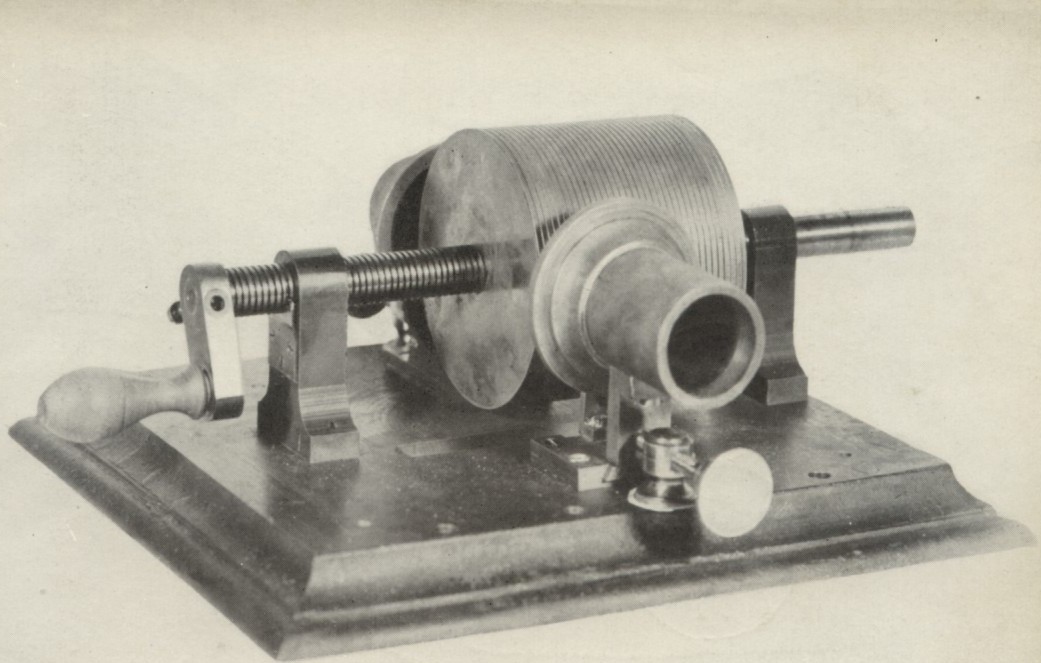
- Edison's original tin-foil phonograph
Wax makes its debut
Some ten years were lost whilst others took up the challenge. Alexander Graham Bell (inventor of the telephone) and Charles Tainter realised that Edison’s phonograph was impractical as it stood. The sonic results were abysmal and the recordings wore out almost immediately. Their development work resulted in the wax cylinder phonograph. A hard-wax removable cylinder replaced the soft tinfoil-covered fixed drum, and the recorder/reproducer moved across the rotating cylinder instead of the other way round. With improvements to the recording and reproducing heads, the sound recorded began to be recognisable.
These developments were not lost on Edison, who turned his attentions back to the phonograph, making further improvements on Bell and Tainter’s work, However, in the meantime, a competitive system had been introduced: the gramophone record.
Berliner and his flat disc
Simpler to play back, and most tellingly, capable of cheap mass production, it was invented by Emil Berliner as a way of avoiding Edison’s patent on cylinders. His ‘gramophone’ was developed between 1887 and 1893. The process was as different from Edison’s as possible. The stylus moved across the recording medium, now a disc rather than a cylinder, and recorded on it by causing a stylus attached to a vibrating diaphragm to cut a groove which oscillated in the lateral plane (from side to side) rather than the vertical (up and down). A track was made in a thin coating of lampblack that covered a metal disc.
When the recording was finished, the disc was placed in an acid bath. The acid etched a groove in the metal where the recording stylus had exposed it. This resulted in a ‘positive’ recording that could in fact be played, however, early on Berliner realised that the individual recordings necessary with the wax cylinder process were a bar to mass exploitation. He discovered that copies of his discs were easily made by electroplating the original disc to provide a negative version with ridges instead of grooves. This metal negative became a stamper for producing identical copies in a steam-heated press.
-

- Berliner Gramophone 1888
Berliner’s gramophone records were more convenient, cheaper to make and much louder in reproduction. The first commercially marketed ‘acid-etched’ process discs were almost all of an ephemeral nature, with popular songs and brass bands leading the way.
[Audio example 1. An 1898 etched Berliner.] (mp3 file)
The beginning of an industry
These early discs showed that music recording could be a successful business, but the process and the gramophones to play them on were still too crude to make serious music a viable proposition. Improvements soon came via the same idea as Bell and Tainter had had – wax was an ideal medium to make recordings on. Once the problem of electroplating the finished wax, and the little matter of Bell and Tainter’s patents, had been solved, the gramophone began its role of a serious musical reproducer.
The improved fidelity of the wax master that replaced the crude (and noisy) acid-etched system in 1901 was a great step forward, and did much to persuade household names to make records when hitherto the gramophone had been little more than a toy. Caruso, Chaliapin, Melba and Patti et al turned the talking machine into an instrument fit for the front parlour. The increase in record size from 7 inches to 10 inches (and soon after to 12 inches) was another significant factor.
In conjunction with the new recording method, a series of tours, first in Europe, but soon extending to Russia and India, were undertaken by brothers Will and Fred Gaisberg (originally Berliner’s agents, by then working for the Gramophone and Typewriter Co. which later became HMV and now EMI), who from 1901 onwards were bringing back wax masters, made often in hotel rooms, of opera arias sung by Caruso, Tamagno, Battistini, Chaliapin and others, resulting in discs that sold in relatively large quantities. Then as now, the popular and ephemeral earned the money to pay for the prestige recordings of Caruso and co.
-
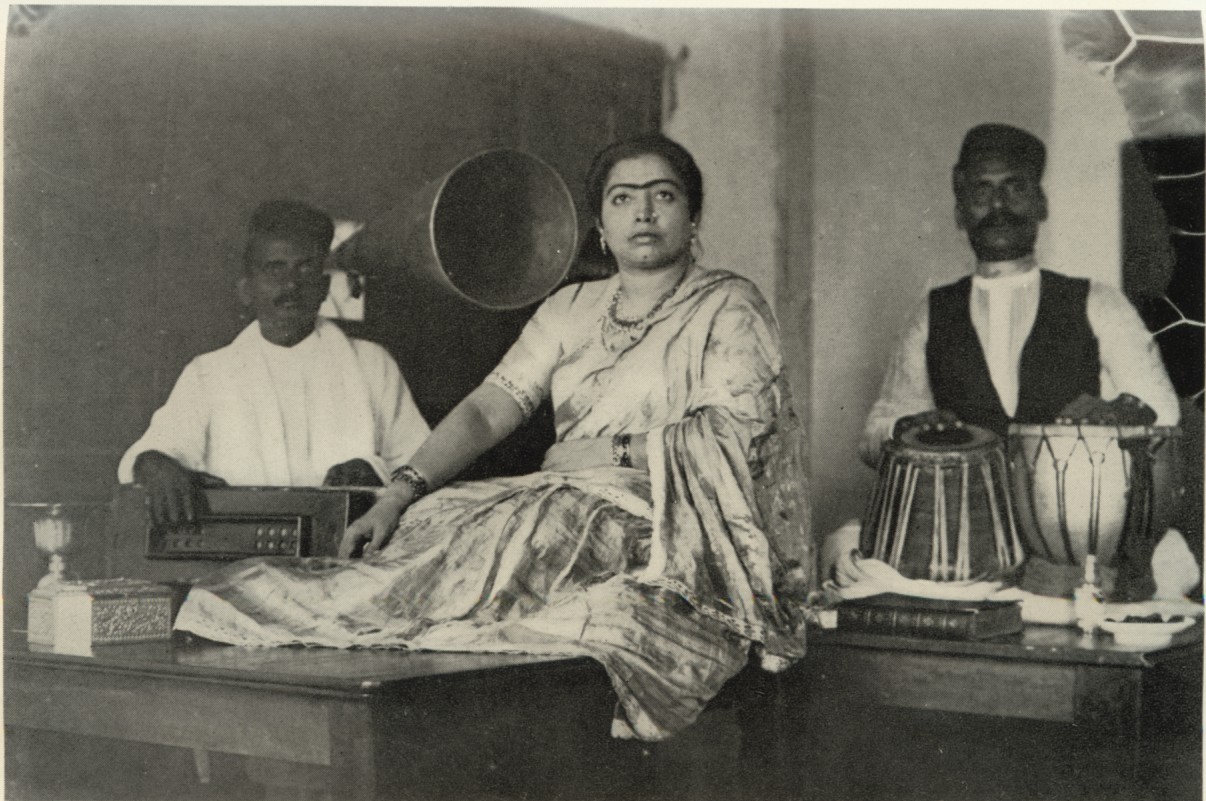
- A photograph taken in Calcutta during Fred's 'Grand Tour'
Celebrity records and Caruso
The first ‘celebrity’ recordings of 1901, carrying the soon-to-be-famous red label, were in fact made in Russia, and featured stars of the Imperial Russian Opera including Chaliapin, Nikolai Figner and his wife Medea Mei-Figner.
Successful though these early Russian recordings were in their native land, they had little impact elsewhere. Then in 1902 came one of those happy events that changed everything. Caruso was first recorded, and in conjunction with the immense popularity of the verismo operas of Puccini, Leoncavallo and Mascagni, for whom he was an ideal interpreter, the gramophone was ‘made’ as a vehicle for classical music.
Incidentally, should you come across the old story about how Fred Gaisberg wired his employer for permission to record Caruso in Milan for £100 only to receive the answer ‘Fee exorbitant, forbid you to record’, discount it. Uncle Fred was a past master at telling good stories. There is no evidence whatsoever for believing it!
Caruso’s first records were best sellers: he was, as Gaisberg later said, “the answer to the recording man’s dream”. He recorded well and his records sounded relatively rich when played on the primitive gramophones of the time. So popular were they that some of the masters wore out, and he had to re-record them in the November of that year. This was before they were able to make multiple stampers from a single master.
Standardisation and its effect
From here on, technical developments were rather slower, and it might be argued that the vividness of these early recordings was lost as the move towards a standardised and smoother sound was called for – this for reasons of record wear. The louder and more vivid the recording, the more easily the record wore out when played with the heavy and stiff playback arms of the day. Records that wore out were not a good advertisement. This prompted the wear test whereby a record had to survive a 50 playings test before it would be issued. Thus many Gramophone Company (HMV) and Victor recordings from around 1904 onwards (Victor was the GC’s American affiliate), can be rather less forward than their predecessors. Recognising this problem, in 1911 HMV employed one of its star performers, Dame Nellie Melba (Peach Melba was named after her), to make a ‘Distance Test’ recording in which she sang a phrase repeatedly but at varying distances from the horn.
The loss of immediacy is readily demonstrated as she moves away from the recording horn. As a contrast, the HMV ‘experts’, as the engineers were called, were making extremely forward recordings in Russia. How some passed the wear test is a matter for conjecture
Other companies and systems
Whilst we have concentrated on the Gramophone Company (and by inference Victor in the USA), there were other significant companies operating in the early years of the century. Columbia, which originally used the Bell & Tainter wax cylinder process, had turned to discs, pooling their patents for wax recording with the gramophone companies’ patents for disc recording. Columbia, though, never really committed itself, in either America or Europe, to large-scale classical recording until the electrical era – 1925 onwards. Pathé in France did, but their process on both cylinder and vertically cut discs, involved mechanical dubbing from master cylinders, and was exceedingly poor.
[Audio example 6. A Pathé Hill & Dale recording. A typically thin and wiry sound.] (mp3 file)
The dominance of opera
This was an era when vocal and opera records dominated the classical sections of record catalogues: in Italy the Fonotipia company recorded virtually nothing else. Its Odeon associate was a little more adventurous, but not much. The Gramophone Co. had a reasonable number of instrumental recordings, especially violin, by the likes of Kreisler and Kubelik – both undoubted stars.
-

- Jan Kubelik recording acoustically
Orchestral recording, other than house bands playing overtures to musicals or the ever popular ‘Highlights From’ discs, was fairly rare. However the London Symphony Orchestra, or at least parts of it, did record a number sides in 1913 including an eight-sided version of Beethoven’s 5th symphony as well as various shorter pieces. The conductor was the great Artur Nikisch.
Although poor by our standards, the results were possible to enjoy. As time went on, Elgar began to record his own music, and other conductors followed suit including Toscanini, Landon Ronald and Leopold Stokowski.
-
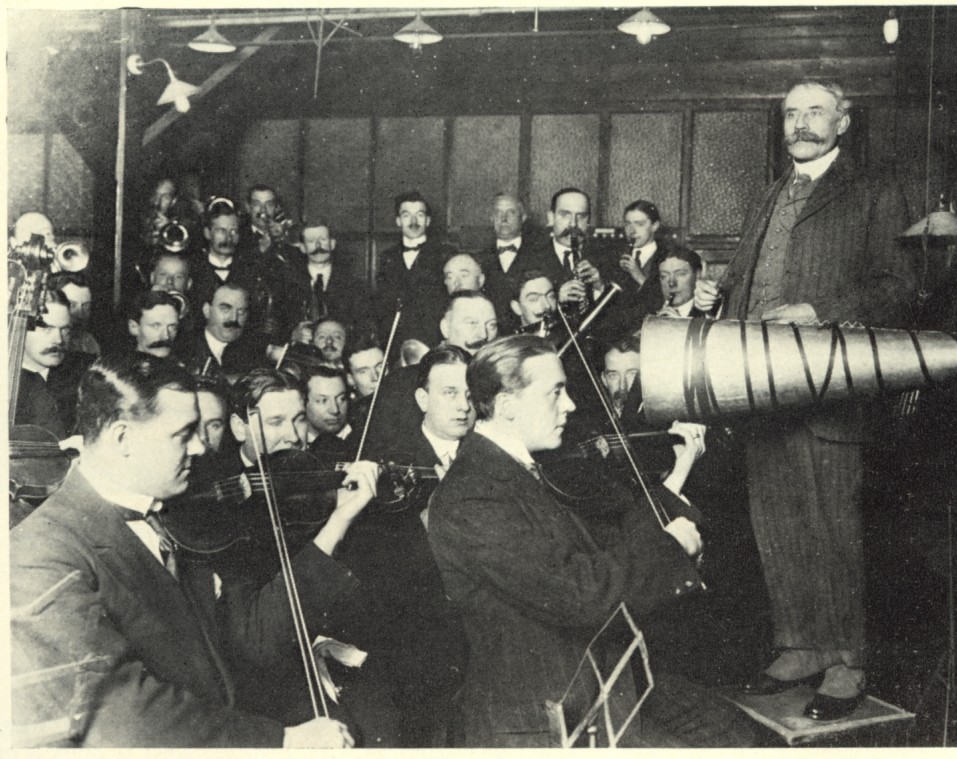
- Elgar recording in 1914
Jazz takes a bow
Another field of musical endeavour that was benefiting from the slow improvements in technology was jazz. In 1918, Victor recorded the first of a famous series of true jazz, as against ragtime, featuring The Original Dixieland Jazz Band.
[Audio example 8. The Original Dixieland Jazz Band (ODJB).] (mp3 file)
A typical recording session of 1920
At this point it will be instructive to get a feel for the way in which recordings were made and to look at some of the technical processes involved. Let us imagine a recording made onto disc in about 1920.
The recording medium was a form of hard wax, prepared at the factory in vats, filtered to keep the mixture as smooth as possible and, after cooling and hardening in circular moulds, turned on a lathe in order to produce a smooth surface. The resulting wax blanks were packed in cases and sent out to the studios. For recording, the wax was placed on the turntable of the recording machine, where it rotated in theory (though by no means always in practice) at 78 revolutions per minute (rpm). The whole turntable assembly moved sideways beneath the cutting head so that a groove was cut in the wax from the outer edge of the wax disc towards the centre. Because it was attached directly to the horn, the cutting assembly was fixed. The stylus was moved by a (usually glass) diaphragm, and, depending on how efficient the connections were, pressure was transmitted more or less accurately. Sound was transmitted to the other side of the diaphragm through tubular connections leading from the narrow end of the recording horn, while the horn itself captured and focussed as much of the performers’ sound output as possible. Horns tended to have resonances of their own, which were damped as far as possible by wrapping tape around them. Multiple horns could be used to capture sound from a larger group of performers or from different parts of a piano, for example, and these were connected up via Y-shaped metal connectors joined to the horn with rubber tubing. The horns were suspended from (or occasionally supported on) stands to minimise strain on the cutting mechanism.
Secrecy
The recording machinery, in almost all the surviving photographs, is out of sight behind the curtain. Partly this was to cut out extraneous sounds, though given the insensitivity of the horn and all the noise generated along the way, it is unlikely to have been audible on disc; more importantly it was to protect company secrets. In those days, recording equipment was not bought off the shelf – each company made its own. What we can see is the horn, suspended by a wire and wrapped with tape; and we can see the very unorthodox arrangement of the musicians in front of it. Although one might suspect that the crowding of the musicians is for the photographer’s convenience, in fact there is ample period evidence that this was normal and necessary in order to get the best possible balance of sound focussed into the horn.
An American studio
For an alternative, American layout, there is one drawn by Fred Gaisberg in 1907, showing more space between the players and the recording horns. Two recording horns are used, with the violins (which recorded least well) nearest to them. Squashed around them are the woodwind players, who would have been reinforcing the string parts. Behind them, but higher, were most of the brass, with the French horns facing backwards in order to direct the sound from their bells into the recording horn, the players following the conductor in a mirror. The conductor is pushed out of the way to the side where he can be seen but doesn’t obstruct the sound. Bassoons reinforce the ‘cellos, and a tuba and contrabassoon replace double basses, which would not have recorded adequately. Another surviving photograph shows Paderewski recording into a pair of horns and, unusually, it allows us to see something of the coupling mechanism. For a typical studio layout for a recording of voice with piano accompaniment, the horn is hung right in front of the singer’s mouth, and the upright piano is set above and behind the singer at a height that ensures that the maximum amount of piano sound enters the horn. Pianists were instructed to play fortissimo throughout. Singers, on the other hand, had to move towards the horn for quieter passages, and away for louder notes to avoid distortion. Inexperienced soloists were guided back and forth by an assistant, sometimes on a form of trolley!
-

- A typical acoustic orchestra recording session by Victor
The recording
Recording proceeded in takes as long as one wax blank took to fill: for early cylinders and discs this was about two minutes; for later cylinders three and then (from 1908) four minutes; for a ten-inch disc about three minutes; for a twelve-inch, just under four minutes at first, and later up to four and a half or slightly more. Pieces that played for longer than this had either to be played quickly (for which there is some evidence, though not as much as is sometimes suggested) or - and this was much more common - had to be cut. If a piece or movement were being recorded that lasted much longer than one side, recording stopped at a musically convenient point in the score, and then continued later when a new wax tablet was in place and everyone was ready to resume. Sometimes side-ends were composed by an arranger, for example adding a perfect cadence to what would otherwise have been an open-ended musical phrase; mostly the musicians closed a side with a modest ritardando. In fact, the engineers did have the ability to vary the lathe’s transit speed resulting in closer groove spacing and longer playing time. In the early 1920s, HMV experimented with sides lasting over 8 minutes, but they were never commercially issued.
The duplication process
After the recording session was over, the wax masters were returned to the factory for electroplating. This produced a negative metal copy which was used to stamp a test pressing. If the musical results and sound quality were considered satisfactory, further negatives were made and nickel-plated for use as stampers.
The negative metal stampers were then used to make copies in shellac, either pressed against a blank for single-sided discs, or against another stamper for double-sided. Once the metal negative was made the original wax master was returned to the lathe to be planed smooth and reused. (In the earliest days, many waxes could be re-plated after the negative was stripped (known as a second shell) to produce a duplicate master negative.)
From this point in the process, it was simply a matter of stamping out as many records as were demanded for sale. See detailed article on duplication process.
Competition
After the end of the First World War the record companies began to face their first serious competition: radio. By the early 1920s, this medium took hold in a very big way, and there was no doubt that the sound quality via the microphone and loudspeaker was far superior to the mechanical recording of the gramophone. This difference was not lost on the companies who in secret began to experiment with means of recording using microphones instead of the horn. HMV had an experimental system up and running by 1924.
Unfortunately most of the results were little better than the old mechanical system. But then came the telephone men.
Bell Telephones to the rescue
Maxfield and Harrison were engineers with the Bell Telephone Laboratories during the 1920s. As part of their work, they developed high quality public address systems. Having achieved that goal, with its necessity for large power outputs with a wide frequency range and low distortion, they turned their attention to recording. For the first time all the elements of recording, from the acoustics of the sound source right through to the machine upon which the record was to be played, were subjected to scientific research. The result was what we now call the Western Electric recording system (or sometimes Westrex). For a full description I would refer you to Maxfield and Harrisons 1926 paper ‘High Quality Recording and Reproducing of Music and Speech’.
Realism
The results blew acoustic recording away virtually overnight. For the first time something like a full orchestra could be successfully recorded. Transients and sibilants were there, studio ambience and atmosphere, and all these things made for far greater fidelity. Now the gramophone could compete with the radio.
Popular music and jazz benefited too.
Hear what it did for the piano.
[Audio example 12. Piano recording changed overnight.] (mp3 file)
And the orchestra.
[Audio example 13. A full orchestra was now possible. Albert Coates in 1925.] (mp3 file)
Within the space of a few weeks, Victor and Columbia in the US (at that time US Columbia was owned by English Columbia), and HMV and English Columbia had converted to the new process. The first electrical recordings were mainly of popular music, but classical soon followed when once the requirements were understood.
Different approaches
Although Victor and HMV were closely affiliated, UK and Continental recording in the early electrical era tended to be rather different in approach from that in the US, where classical recording was concerned. HMV preferred a more spacious sound as these two recordings demonstrate.
-
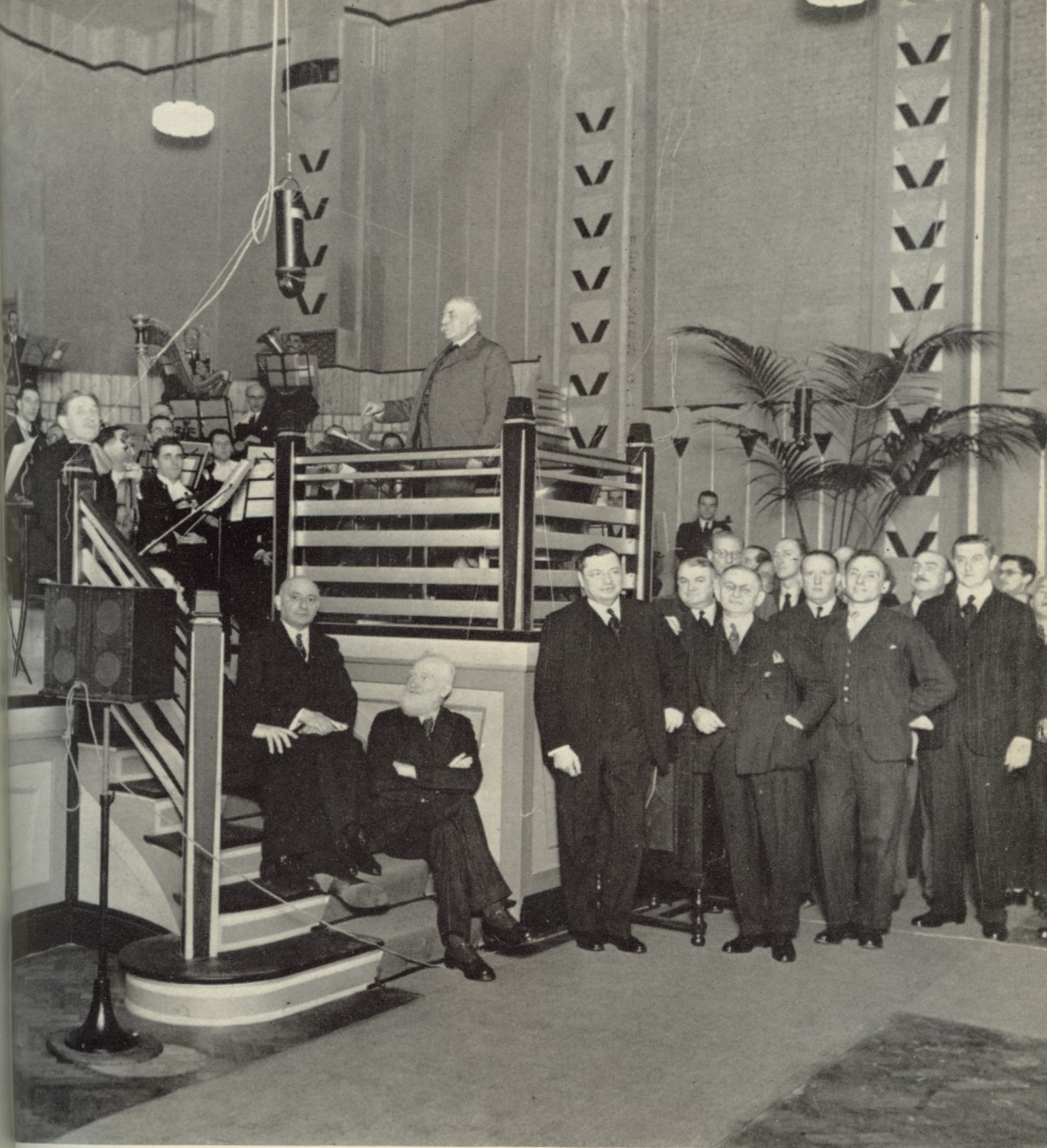
- Elgar at the opening of Abbey Road studios
Live recordings…
Or rather, recordings of public performances. With mechanical recording, it was a virtual impossibility to make recordings of concert performances. Electrical recording changed all that, and from the early days of experimental recordings in the USA, when live performances provided a constant run of free musical signal the engineers to play with, the possibilities were explored. In Britain, within a year of the introduction the new system, the Gramophone Company (His Master’s Voice) formed the ‘Opera House Committee’ (later changed to the ‘Outside Recording Committee’) with a view to recording actual performances. The Royal Opera House, Covent Garden, was obviously a prime venue since so many international stars were contracted to sing there.
Via telephone lines
The idea was that the signals from their microphones would be relayed by Post Office lines to Gloucester House (later to the Small Queen’s Hall) where the actual recording lathes were installed. Thus far reasonably straightforward, although today we cannot really appreciate the technical achievements which were great indeed. One particular problem was that the engineers had no sight of the stage and therefore relied on signals as to when lower the cutter-head, always trying to avoid long silences at the beginning of sides. Sometimes a wanted portion would look to be running too near the label space and a quick fade-out was necessary. There was also a wish not to record applause, and of course the necessity of not recording any artist under contract to a rival.
Money and musician problems – nothing new!
The first of these ‘live’ recordings was to have been a concert performance of ‘Legend of the Invisible City of Kitesh’ on the 30th March 1926. Sadly the orchestra and chorus wanted fees equivalent to a full session at the HMV studios. This was not acceptable and it was not until 31st May 1926 that the series began, with extracts from Boito’s Mefistofele with Chaliapin in the title role. A total of 9 sides were recorded that evening, of which four resulted in successful records that were subsequently published; and despite all the difficulties, some of them are extraordinarily vivid.
Prelude to the big occasion
The following week, on the 4th June, 9 sides were recorded of La Bohème with Margaret Sheridan and Angelo Minghetti. Of these only two survive, neither of which was published, good though they are. Four days later came a milestone in opera history: the farewell performance of Dame Nellie Melba. A total of 11 sides were recorded including speeches by Lord Stanley and Dame Nellie herself.
Just over a week later, the engineers turned their attention to the then greatest living Otello, Giovanni Zenatello. Ten sides were recorded, including the Esultate, for which Zenatello tried to ‘help’ the recorders by coming nearer to the microphones. With his huge voice, the result must have been totally unusable.
1927
No Covent Garden recordings were made in the following year, but HMV did record Chaliapin in a performance of Mozart and Salieri at the Royal Albert Hall. The four surviving sides show the extraordinary progress the engineers had made.
By 1928, large extracts from Chaliapin’s Faust, and Boris Godunov were captured at Covent Garden and these remain some of the most famous ‘live’ recordings ever made.
The cost of Western Electric
The Western Electric system, good though it was, did have a cost. For each record sold and made by that process, a royalty was payable. The system itself was leased rather than sold outright. All the major record companies therefore made serious attempts to develop their own systems that did not infringe WE patents but that would result in equally good or better recordings. Columbia engineers in the UK, led by Holman and Blumlein, were streets ahead in the race. When the Gramophone Co. ‘merged’ with Columbia in 1931, it became heir to what is today called the Blumlein system. The WE system used a moving-iron cutter head that was heavily damped to prevent the inherent resonances: the Blumlein cutter was a moving coil type which used feedback to damp the movement. The recordings made with it tend to have a freedom that could sometimes be missing from the WE system. More importantly for EMI, it was free of royalty payments.
The Blumlein cutter was the basis for virtually all today’s disc cutters. Blumlein himself went on to develop stereo recording on disc and film before getting involved in secret radar work for the Government. He was killed whilst testing airborne radar when his plane was shot down during the war.
-
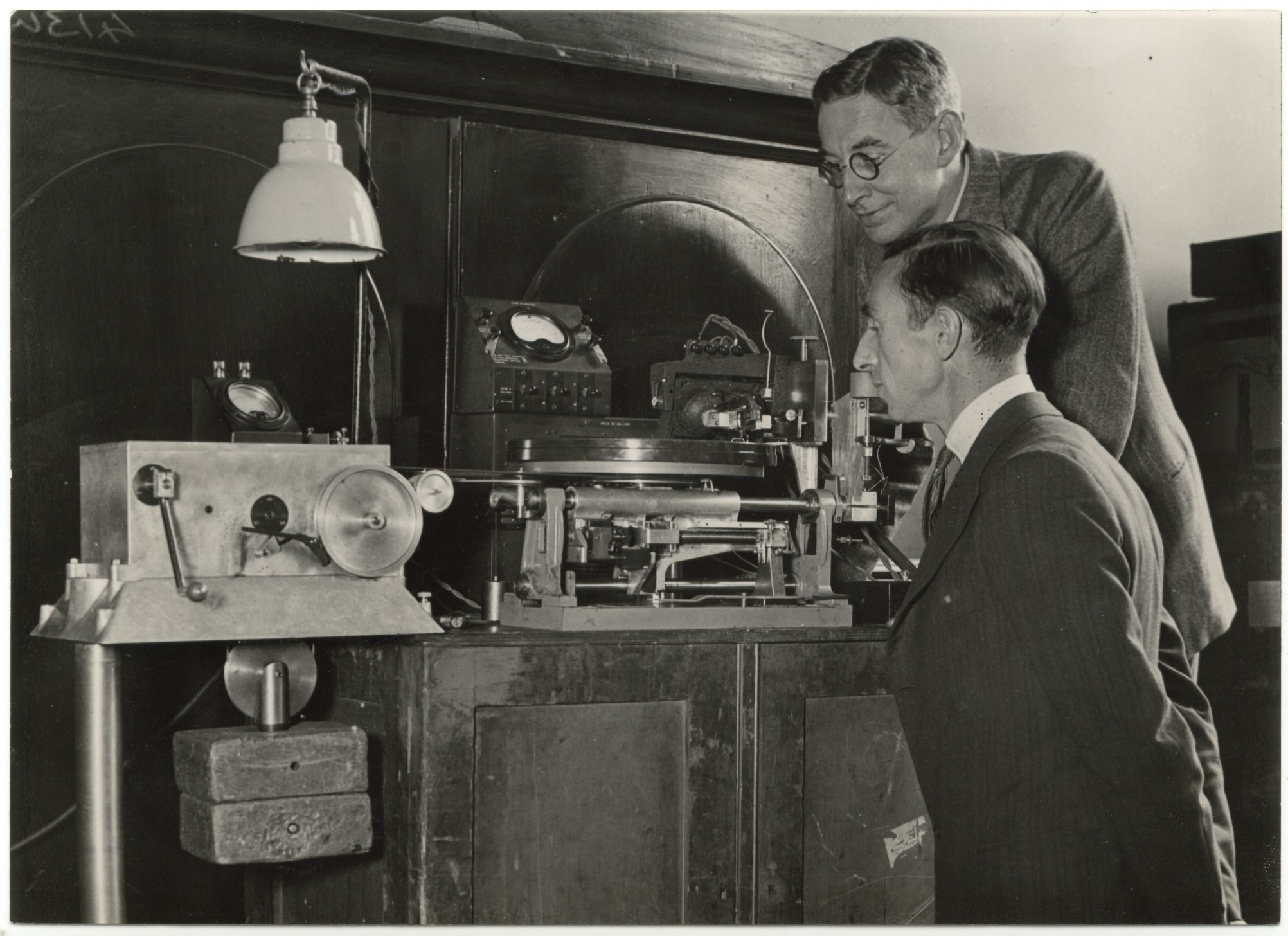
- The Blumlein lathe
America
As might be expected, the Americans were trying to do exactly the same thing – to circumvent the WE patents. RCA developed its own ‘HQ’ or high-quality cutter which became the basis of its post-WE recordings. It was certainly capable of producing loud records, and RCA wasted no time in exploiting that feature.
Films and LP
The first soundtracks for films were recorded on discs using the ‘Vitaphone’ process – in reality Bell Laboratories and Western Electric - and played in mechanically-locked synchronism with the film projection. However, in order to make a coarse-groove disc run for the same amount of time as a 1000-foot reel of film - about eleven minutes - the disc had to be run at 33⅓ rpm and increased in size to around 17 inches! Although the famous Al Jolson film, ‘The Jazz Singer’ is thought of as the first true sound-film, the series of Vitaphone shorts preceded it by a couple of years. Many of the top Metropolitan Opera stars took part in these ‘shorts’, amongst then Giovanni Martinelli.
Considering its date, and slow speed, the results are remarkable, and far better than the contemporary sound-on-film systems, although much more cumbersome of course.
For professional use only
Such a format was never going to be suitable for home music reproduction. But it did give a taste of longer playing times, and RCA Victor decided to try a longer playing record on the public: in 1931 they introduced a standard sized, semi-coarse grooved LP running at 33⅓ rpm using their ‘HQ’ cutterhead. These first LPs were not an unqualified success. America was in the middle of a depression and money was scarce. The new records needed specialist replay equipment that was not sold cheaply – a mistake Columbia did not make when post-war LP was introduced. Even for those who did invest, the promises of high quality with long playing time did not quite work out. Too often the quality was poor, and in fact most of the LPs were actually dubbings from 78s. One interesting experiment was a recording of Beecham conducting the New York Philharmonia Orchestra playing Strauss’s Don Quixote, op. 35. It was recorded on the 7th April 1932 both on 10 standard 78 rpm sides and on 5 LP sides. The results were very variable.
-
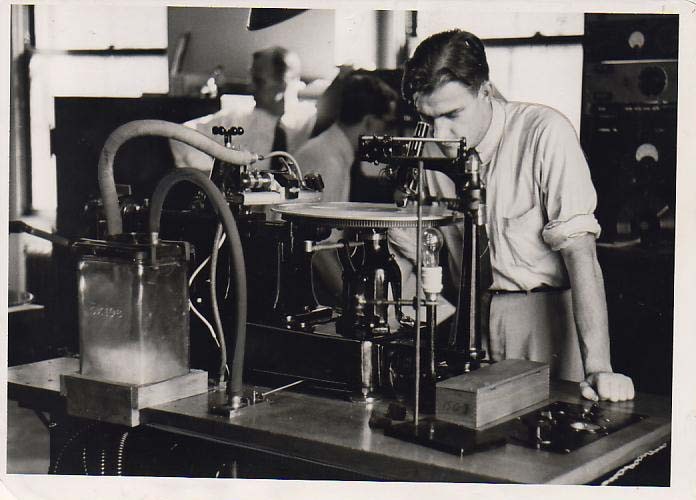
- An American transcription lathe
-
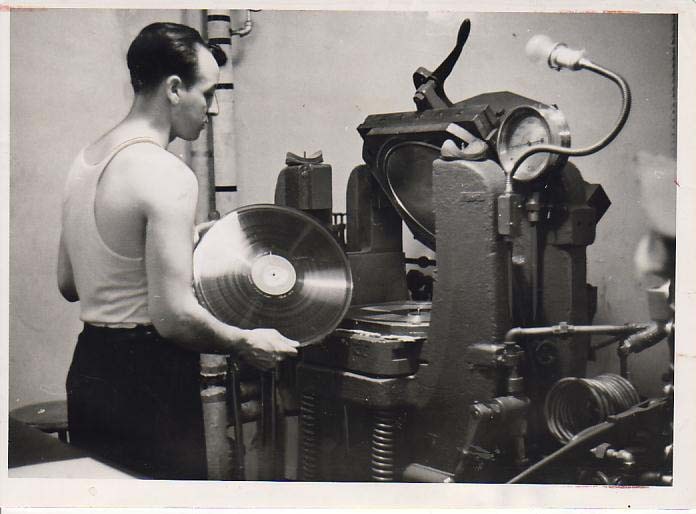
- A press for 16 inch transcription discs
Although pre-war LP was not a commercial success, it did hang on until the late 1930s. However 16 inch 33⅓ rpm discs did survive to become the standard for American radio stations – known as transcription discs.
The post-war 78
Up until the beginning of the war, the average 78 had a fairly clean response up to around 8500 c/s and sometimes more. Not hi-fi, but because what was there was clean and undistorted it sounded very good, and so obviously had improved during the decade.
More, however, was to come with the ability to store a much wider range of frequencies - up to 14,000Hz and more - on disc. This came about with the need by various government agencies to be able to record higher frequencies for a variety of secret purposes, including anti-submarine warfare. In this, Decca were at the forefront of the work, which culminated in their post-war ‘Full Frequency Range Recording’ (FFRR) system.
EMI of course were not too far behind with ‘Extended Range Recording’, although some of the technology relied on RCA cutterheads.
[Audio example 25. EMI’s Extended Range Recording. Halina –Stefanska, Chopin.] (mp3 file)
Tape
Although first invented in 1899, magnetic recording needed sophisticated electronics and a reliable medium. While some work was carried out in the US and Britain, it was the Germans who really made it all work. When the Allies requisitioned German radio stations in 1945, tape recording was found to have advanced way beyond pre-war capabilities. Among the material recovered by the Russians were tape recordings in stereo, a few surviving examples of which resurfaced in the 1990s including an astonishingly clear recording of Bruckner’s 9th Symphony under Karajan recorded in Berlin in 1944. Compared to performances on contemporary 78rpm disc it is truly remarkable. Several of the Magnetophon recorders were ‘liberated’ by the Allies, and these formed the basis for the American ‘Ampex’ model 200 that revolutionised US recording, and in Britain the EMI BTR 1 machine. Gone forever was the need to record everything in 4½-minute bits. Half-hour tapes could accommodate whole movements of a symphony. But then came the scissor and sticky tape boys, and nothing has been the same ever since. The ability to edit seamlessly was the final piece in the jigsaw for the Long Playing Record.
LP again
So it was that by the time the recording industry began to recover after the War all the technology was available to produce long-playing discs with a much better frequency response, carrying recordings that had been edited to give the cleanest possible performance.
Epilogue
This is not the place for a history of recording from LP onwards. There are plenty already on the shelves. Suffice it to say that for all its convenience (replaced of course by the CD), the LP lacks the immediacy and that partial illusion of a live performance that characterises the 78. By the early 1950s, all 78s were purely transfers from tape, and in that form held on for a few years before being completed ousted by the LP.
Ave atque vale.
Caveat and a short list for further reading
This has been a brief look at the history of recording, principally on disc. Of necessity, some technical explanations have had to be simplified and much of the chronology compressed. For further reading, the following will repay their study.
H. Courtney Bryson. The Gramophone Record. (Ernest Benn & Co. 1935). An exhaustive study of the manufacture of gramophone records at that time.
Roland Gelatt. The Fabulous Phonograph. (Cassell 1956 & rev.). A good general history.
Welch and Read. From Tinfoil to Stereo. Good for the early history.
Fred Gaisberg. The Music Goes Round. Romanticised version of the history to 1939, with many inaccuracies, but entertaining and useful nonetheless.
Joseph Batten. Joe Batten’s Book. (Rockliff 1956). Another useful work, especially as seen from the Columbia perpective.
Geoffrey Jones. The Gramophone Company: an Anglo-American multinational, 1898-1931. Business History Review, Vol. 59, No. 1 (Spring 1985); pp. 76-100.